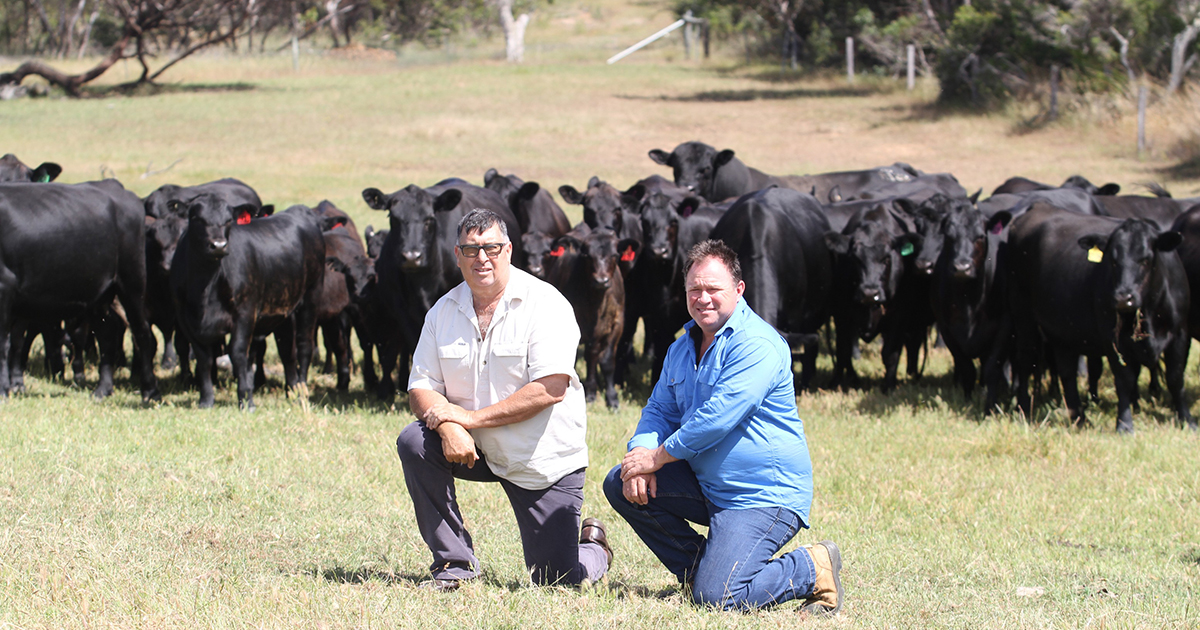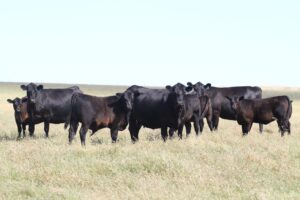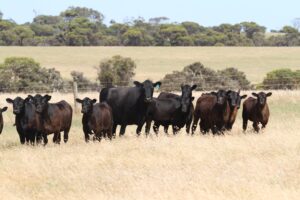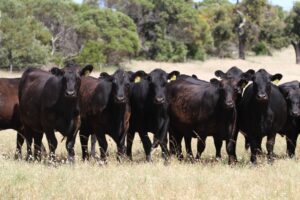Breeding the best at Esperance


The Graham family runs a mixed farming enterprise spanning 6000 hectares at the coastal localities of Monjingup and Dalyup, west of Esperance in Western Australia, with Dalyup manager Scott Watkins and three farm employees.
Their Angus breeding herd sits at 2500 females (including heifers), grown from humble beginnings and on business values instilled in Wes by his late father George (tragically killed in a car accident when Wes was 22 years old and on agriculture exchange in Texas) of seizing opportunities and the importance of relationships.
The Graham family moved to their new half-cleared home at west Esperance from the Mallee region in Victoria in the early 1960s and set about expanding their holdings to the north.
The family also owned Black Flag sheep station, just north of Kalgoorlie.
Following the death of their father in 1985, Wes and his brothers Rory and Steve decided to run their own farming operations and are also still farming today at Salmon Gums and Wittenoom Hills respectively.
“Dad was looking for opportunity and based his family close to Esperance and basically went back to Mallee farming at Salmon Gums,” Mr Graham said.
“He was a hard worker and wanted to farm all different things, even to come here in the ’60s and still farm 100 kilometres away.
“Esperance was built on people like dad who were prepared to leave their roots and develop the region.
“He had a succession vision for my brothers and I which was before its time, he always said you will be your own boss before you realise which gave us confidence when we left school.
“Before I went away on an ag exchange I found those years working beside dad very valuable.”
In the early years the Grahams were running a mixed herd of 300 mostly Angus breeders, with bulls sourced locally and from the late ’80s European breed sires were introduced which would ultimately lead Wes down the Angus path.
“With the arrival of Euro breeds, crossbreeding became popular and after trialling a couple of different breeds, I realised to have a good crossbreeding herd you have to have a good straightbred herd so I decided to go down the straightbred line and produce good Angus,” he said.
“An old adage I’ve carried is if you’re going to breed one, breed a good one and selection for quality in my breeding program stemmed from there.”
Wes said he felt to get genetic diversity he was prepared to travel to source bulls without bias from large and small WA stud breeders which he continues to do today.
 “I could see the Angus Society was starting to modernise and compete with the Euro breeds, building the breed with a bit more size and carcase traits,” he said.
“I could see the Angus Society was starting to modernise and compete with the Euro breeds, building the breed with a bit more size and carcase traits,” he said.
“The Kojonup bull trials were happening around these times and they struck my interest with what Angus was doing.”
“From the crossbreeding days, I feel spreading genetics is a good insurance policy and always looking for new genetic lines is like crossbreeding with the hybrid vigour effect through broad genetics,” he said.
“I felt diversity was the best option and I was prepared to travel to buy bulls, including from small studs which can produce top quality animals like the big studs.”
Mr Graham said as he expanded his holding, he went from selling baby beef off mum through the ’90s to value adding and taking the calves through to finishing off grass as yearlings to utilise the bigger acreages.
The Grahams shifted from an autumn to winter calving in the early 2000s and during a couple of tight feed seasons later in the decade, adversity would plant the seed of a successful 12-year relationship with Ivan and Jill Rogers, Kylagh Feedlot, Tammin.
“Changing to a winter calving did change the dynamics, it’s great from a feed requirement basically calving onto green feed but it does limit your finishing capabilities of yearling cattle,” Mr Graham said.
“In a tight year I sent around 200 steers to Ivan on a custom feed and 200 to Denbarker on agistment.
“It gave Ivan the opportunity to see how my steers performed and they went really well on feed while the steers on agistment experienced a dry season and I had to quit them earlier than I would have liked to market them and take a discount as they weren’t finished and too heavy to feed.
“And that’s what headed us down the custom feeding relationship with Kylagh Feedlot.”
The Grahams wean their calves in February-March and background them until they reach about 350kg liveweight before the cattle go on a custom 100-day feed program from June onwards for Coles Finest premium beef label aiming to average 300kg dressed weight.
Mr Graham said the relationship with Ivan Rogers was possibly the best thing that had happened to them from a cattle business point of view.
“Over the years I carried on the tradition of dealing direct with all the butchers and felt it’s important to have a good relationship with the next person along the line,” he said.
“The success of our business is carrying the animal through to the end product, it’s tried and true and a comfort factor when you get to a point you’re producing quality beef for a quality contract.
“Ivan is a very good operator, honest and loyal and our relationship is a win/win for both of us.
“He had trouble finding his product for the winter period so I filled the void with my winter-drop cattle.
“And more recently when cattle had been harder to find, he can call me and I’m prepared to send them 25-30kg lighter and be on feed for an extra 20 days to help his in/out system, so it goes both ways.”
The Grahams also sell 200-300 surplus heifers annually to the Rogers for their Wagyu breeding program.
Mr Graham said backgrounding was widely understated in the industry but an important part of their system.
“There isn’t necessarily any profit in backgrounding but I do it for my own long term benefit,” he said.
“I believe it’s important for animals to learn to graze well and work for their feed which is a positive for the feedlot.
“I’m not trying to put much weight on the cattle from weaning to the feedlot, but producing an animal with the ability to do more than 2kg per day on feed.
“It’s the same with sheep, you’re setting them up for a strong crack at the growth period, they’ve got maturity, frame and can just produce meat.”
Replacement breeding heifers are selected at weaning as opposed to before joining which Mr Graham attributes to selecting on maternal traits of the herd as well as growth.
He said growth for age was still king, but by selecting off mum, you see early growth, a good looking animal, conformation and do-ability, while also assessing the cow through days to calving, early drop, getting in back in calf, milk and mothering ability.
Mr Graham said in ordinary feed seasons he learned a lot about compensatory gain in genetics and how they influenced his cattle’s performance in the feedlot.
300kg dressed weight within 100 days,” he said.
“To think they could catch up 50kg plus 200kg they would normally put on through the growth period was incredible, doing 2.5 -2.6kg per day and influenced by climate.
 “And it gets back to selection, I’m not selecting them to be heavy weaners, I’m selecting them to perform well right through to the end product.”
“And it gets back to selection, I’m not selecting them to be heavy weaners, I’m selecting them to perform well right through to the end product.”
In regards to bull selection, Mr Graham said EBVs were a great guide, along with visual appraisal, and he looked for top percentage of breed for growth, carcase weight and the ability of the animal to get to target weight at a younger age.
“With the climate conversation, targeting animals that are going to finish at a younger age is going to also be a positive from an environmental perspective,” he said.
The Grahams carry a battery of between 60 to 70 bulls and run a small nucleus herd of 50 breeders as a cost-effective way to breed their own heifer joining bulls to cover 400 heifers.
To utilise genomics, they registered these breeders as the Monjingup Angus stud.
“It’s a stud that backs my commercial business only and the genomics add to EBVs for more accuracy in my bull breeding,” he said.
“These bulls have to be in the top 10 per cent of the breed, we don’t mate heifers to average bulls because the production of their 320-330 progeny has to be profitable also.”
The Grahams also crop 1200 hectares annually to canola, lupins, wheat and barley and oats to produce between 2000-3000 hay rolls for the autumn feed gap.
They also run the Monjingup Poll Dorset stud and mate 2500 commercial ewes to their own Monjingup rams.
 Early this year Wes and Fran Graham put up 10 Angus heifers as part of the in the 2022/23 edition of the annual Farm Weekly/WA Angus Breeders Win 10 Angus heifers and Nutrien Ag Solutions Merchandise Package Competition.
Early this year Wes and Fran Graham put up 10 Angus heifers as part of the in the 2022/23 edition of the annual Farm Weekly/WA Angus Breeders Win 10 Angus heifers and Nutrien Ag Solutions Merchandise Package Competition.
In its 16th year, the lucky winners were Rob and Lois Johnstone, Napier WA.
Mr Graham said it was a privilege to be involved in this year’s competition.
“I’ve been reluctant to supply the heifers because of their later winter calving but they’re only young once and someone will have the opportunity to take them forward to their mating time for future years,” Mr Graham said.
“It’s an honour for Fran and I and the team that the Angus Society would consider us to give someone the opportunity with some of our Angus breeding given we are a long way from the rest of the State.”
Mr Graham said the Angus Society was a market leader in creating a better product.
“There are a lot of passionate producers involved in the society, past and present, that have been Australia-wide leaders in the Angus breed,” he said.
It’s not the first time the WA Angus Society has recognised Wes Graham for his commitment, contribution and passion to the Angus breed when he became the first commercial producer to be awarded the prestigious Strathtay Trophy in 2018.
When presenting the award, then WA Angus Society chairman Tony Sudlow said Mr Graham was a worthy winner of the award for his continued support of the Angus breed and WA Angus stud breeders.
“Wes is very passionate about his breeding program and the Angus breed,” Mr Sudlow said.
“He runs one of the State’s biggest purebred Angus herds and his depth of knowledge of the breed’s genetics is excellent and probably better than a lot of stud breeders.
Mr Graham said it was a great honour to win the award and showed how important the whole industry was.
“I enjoy the game of breeding the best Angus I can,” he said.
“Quality is the most important thing and if you produce a quality product you need to start with a quality product and that is why I started travelling the State looking for the best Angus genetics.
“I believe every WA Angus stud has the ability to produce top animals today and I like to support them.”
By Kane Chatfield, Farm Weekly
Feature image: Wes Graham (left), WJ & FJ Graham and Monjingup Angus, west Esperance and Angus Australia Board Member, Andrew Kuss, Allegria Park Angus stud, Esperance, with some of the Graham family’s mature Angus cows and May-June 2022-drop Angus calves.